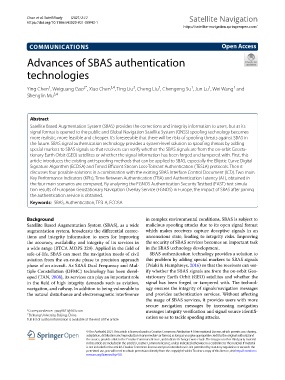Page 56 - 卫星导航2021年第1-2合期
P. 56
Chen et al. Satell Navig (2021) 2:12 Satellite Navigation
https://doi.org/10.1186/s43020-021-00043-1
https://satellite-navigation.springeropen.com/
COMMUNICATIONS Open Access
Advances of SBAS authentication
technologies
3
3,4
1
2*
1
1
1
1
Ying Chen , Weiguang Gao , Xiao Chen , Ting Liu , Cheng Liu , Chengeng Su , Jun Lu , Wei Wang and
3,4
Shenglin Mu
Abstract
Satellite Based Augmentation System (SBAS) provides the corrections and integrity information to users, but as its
signal format is opened to the public and Global Navigation Satellite System (GNSS) spoofng technology becomes
more realistic, more feasible and cheaper. It’s foreseeable that there will be risks of spoofng threats against SBAS in
the future. SBAS signal authentication technology provides a system-level solution to spoofng threats by adding
special markers to SBAS signals so that receivers can verify whether the SBAS signals are from the on-orbit Geosta-
tionary Earth Orbit (GEO) satellites or whether the signal information has been forged and tampered with. First, this
article introduces the existing anti-spoofng methods that can be applied to SBAS, especially the Elliptic Curve Digital
Signature Algorithm (ECDSA) and Timed Efcient Stream Loss-Tolerant Authentication (TESLA) protocols. Then it
discusses four possible solutions in a combination with the existing SBAS Interface Control Document (ICD). Two main
Key Performance Indicators (KPIs), Time Between Authentication (TBA) and Authentication Latency (AL), obtained in
the four main scenarios are compared. By analyzing the EGNOS Authentication Security Testbed (EAST) test simula-
tion results of European Geostationary Navigation Overlay Service (EGNOS) in Europe, the impact of SBAS after joining
the authentication service is obtained.
Keywords: SBAS, Authentication, TESLA, ECDSA
Background in complex environmental conditions, SBAS is subject to
Satellite Based Augmentation System (SBAS), as a wide malicious spoofng attacks due to its open signal format
augmentation system, broadcasts the diferential correc- which makes receivers capture deceptive signals in an
tions and integrity information to users for improving unconscious state, leading to integrity risks. Improving
the accuracy, availability and integrity of its services in the security of SBAS services becomes an important task
a wide range (RTCA MOPS 229). Applied in the feld of in the SBAS technology development.
safe-of-life, SBAS can meet the navigation needs of civil SBAS authentication technology provides a solution to
aviation from the en-route phase to precision approach this problem by adding special markers to SBAS signals
phase of an aircraft. As SBAS Dual Frequency and Mul- (Psiaki & Humphreys, 2016) so that the receivers can ver-
tiple Constellation (DFMC) technology has been devel- ify whether the SBAS signals are from the on-orbit Geo-
oped (TAN, 2008), its services can play an important role stationary Earth Orbit (GEO) satellites and whether the
in the feld of high integrity demands such as aviation, signal has been forged or tampered with. Te technol-
navigation, and railway. In addition to being vulnerable to ogy ensures the integrity of signals/navigation messages
the natural disturbance and electromagnetic interference and provides authentication services. Without afecting
the usage of SBAS services, it provides users with more
secure navigation messages by increasing navigation
*Correspondence: gwg9821@163.com messages integrity verifcation and signal source identif-
2 Beihang University, Beijing, China cation so as to tackle spoofng attacks.
Full list of author information is available at the end of the article
© The Author(s) 2021. This article is licensed under a Creative Commons Attribution 4.0 International License, which permits use, sharing,
adaptation, distribution and reproduction in any medium or format, as long as you give appropriate credit to the original author(s) and
the source, provide a link to the Creative Commons licence, and indicate if changes were made. The images or other third party material
in this article are included in the article’s Creative Commons licence, unless indicated otherwise in a credit line to the material. If material
is not included in the article’s Creative Commons licence and your intended use is not permitted by statutory regulation or exceeds the
permitted use, you will need to obtain permission directly from the copyright holder. To view a copy of this licence, visit http:// creat iveco
mmons. org/ licen ses/ by/4. 0/.

